MOTHER LAND MISSED
THE BECOMING LANDSCAPES OF CLEMENTINA,
VISCOUNTESS HAWARDEN, AND SALLY MANN
CAROL MAVOR
The landscape is teasingly slow to give up its secrets.
Sally Mann
Carol Mavor
I have just finished waiting, savoring, pushing, worrying, panting through the cycles of a book, Becoming: The Photographs of Clementina, Viscountess Hawarden. (I am postpartum.) Hawarden took hundreds and hundreds of sensual (I argue erotic) photographs of her adolescent daughters in the emptied parlor-turned-studio of her South Kensington home in the early 1860s. From her first encounter with photography in 1857 to her sudden death in 1864, at age forty-two, Hawarden gave birth to the last three of her eight children, while producing over eight hundred photographs. A (re)productive woman: her photographic years, like a woman's childbearing years, were fleeting. A brief life, a brief photographic career—she was almost missed altogether by history.
The first pages of Becoming emphasize how this Victorian photographer-mother (full of secrets) is always just missed. Hawarden and her work will always remain young, a fleeting moment marked by death and by the absence of information, mature life, images of self, and diaries. Lewis Carroll, a man who left an excess of information (letters, diaries, books, photographs) and secrets all his own, records meeting Hawarden only once (in a diary entry for June 24, 1864).[1] He mentions seeing Hawarden again one month later (in an entry for July 22, 1864), but only from a distance. Writing of that missed meeting, Carroll fore
Mothers embody the state of being missed. It is a cliché to miss your mother. But it is also a cliché that you can never get all of her, that she is never fully gotten, that she is “just missed.” J.M. Barrie made this Wendy's problem in Peter Pan. (The problem was really Barrie's problem, but that is another story.) Wendy's mother “was a lovely lady, with a romantic mind and such a sweet mocking mouth. Her romantic mind was like the tiny boxes, one within the other, that come from the puzzling East, however many you discover there is always one more; and her sweet mocking mouth had one kiss on it that Wendy could never get, though there it was, perfectly conspicuous in the right-hand corner.”[3]
The British child analyst D.W. Winnicott noted how children always see their mothers as keeping something from them, as hiding secrets. In Winnicott's practical hands, the mother becomes, not an orientalized series of nesting boxes, but a mundane middle-class handbag: “Surely there is a little bit of herself that is sacrosanct, that can't be got at even by her own child? Shall she defend or surrender? The awful thing is that if the mother has something hidden away somewhere, that is exactly what the small child wants. If there is no more than a secret, then it is the secret that must be found and turned inside out. Her handbag knows all about this.”[4]
I too, condemned to this state of having “just missed” Hawarden, was to learn, after staying at what had been advertised in one guidebook as Hawarden's old Irish home (in Dundrum, County Tipperary), that her “real” home was down the road. Fantasies of sleeping in the bedroom of Hawarden or her daughter Clementina, her favorite model and namesake, were snatched away. (I was at a Hawarden home, not the Hawarden estate.) And, as if that were not enough to miss, I accidentally exposed all my film of the beautiful rainy, cow-littered, ruinlittered,
But what I intentionally missed in Becoming were the photographs Hawarden had taken at the family estate in Ireland. Relatively limited in number, the Dundrum photographs are seemingly unlike the suprainteriorized photographs of the girls taken at their London home, at 5 Princes Gardens. The South Kensington photographs of her adolescent daughters, posed with pretty objects from Hawarden's collection (such as an Indian traveling cabinet, a cheval glass, or a curvaceous vase) in elaborate costumes (evoking Mary, Queen of Scots, or a Spanish dancer or a concubine in Orientalized dress), picture a fetishized beauty. The details of the girls and their things emphasize the highly feminized interiority of the girls as dolls in their dollhouse home, caught by their mother's camera box. The Dundrum images are mostly of the huge ancient trees on the estate, often coupled with a daughter, who is dwarfed by the beautiful but imposing landscape, as if the grounds were an extension of her crinoline.
In one such picture, from 1858–61, Clementina, in a billowing skirt, bell sleeves, and a smart hat, is a doll to the big-tree-as-mother that guards her (Figure 5). The tree, whose leafless broken limbs anthropomorphically reach and poke, like old bones, out of the lush, lush vines that wrap her aging wooden skeleton, is an image of regeneration. In my eyes, Sally Mann's Sempervirens “Stricta” (1995) regenerates Hawarden's picture through her own particular lens: Mann features her daughter Virginia, dwarfed by the formally planted trees of Tuscany, which look to be made of dried bones, with their own dense leafy dresses (short and long) of rich spongy grassy growth (Figure 6). These mother-trees never stop drying/dying out and never stop growing. In time, Clementina will become her mother, the land that she stands on. Virginia will take her beautiful Italian bicycle down the inviting path, through the opening in the trees, spotted with a foggy light, through a Mother Land, both foreign and inviting, fecund and barren, repetitive and unpredictable, gross and delicious.
Hawarden's Irish photographs, like the London pictures, are of a circumscribed area of activity: the two bodies of work, one outside and one inside, play a stereotypically “naturalized” Ireland against a “cultured”
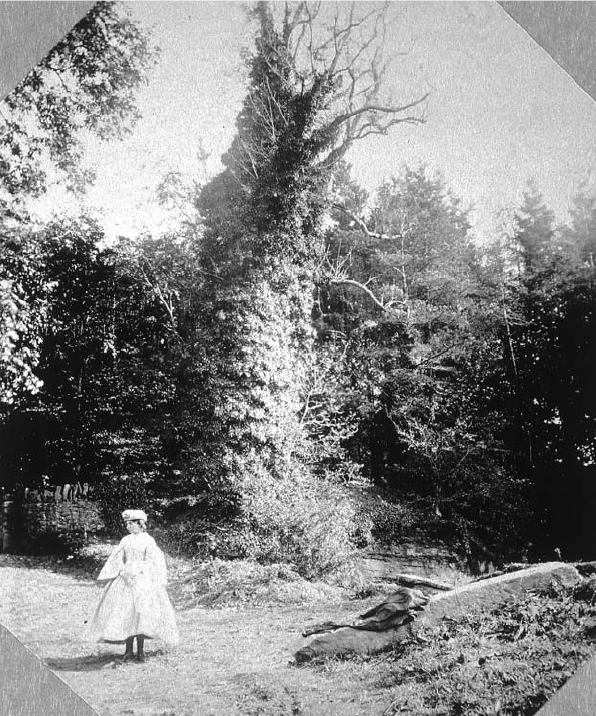
5. Clementina Hawarden, Dundrum Series, 1858–61, photograph
Although I missed Hawarden's landscapes on purpose, I miss them: the trees, the river, the quarry and its rocks, the twisting paths. They are not in the book. Many of them are beautiful. More of them are boring. They are pictures of a mother land missed.
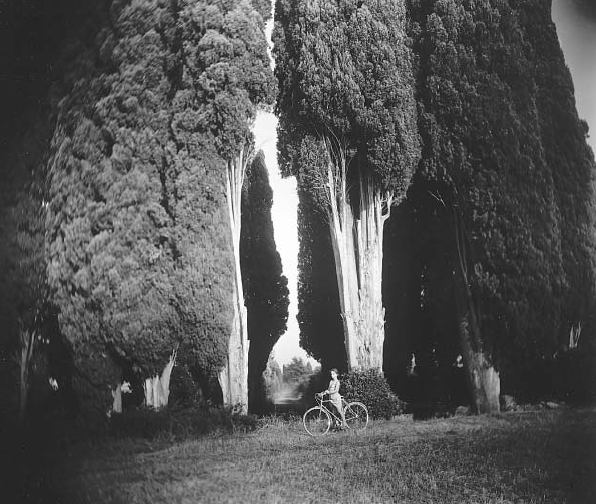
6. Sally Mann, Sempervirens “Stricta,” 1995, silver print
I missed them on purpose because I did not see her (or her children) there. (Yet now, looking back, I remember how I felt Hawarden there as I walked the paths of Dundrum, muddying the hem of my big corduroy dress whose gathers of soft heavy fabric gave growing room to my big round pregnant belly. I was “with child,” as my artist almost always was: “a child every year or every other year.”[5] I look at another photograph of Clementina on the Dundrum House grounds next to Amy's photograph of me: I become Clementina, who is both mother and daughter: dressed and photographed in light and dark, we touch the earth, are touched by earth. In both pictures the mother is there, but missing.
Perhaps I have set apart her landscapes, even landscapes in general, in much the same way that I have set apart the boring parts of her motherhood, and even my own. The dishes, the diapers, the endless picking up, the folding of clothes, the sorting of toys, the wiping off of all things sticky, making real lunches every day, eating unspicy food, the drone of clothes dryers and dishwashers, and the anxious knock of
Returning from Ireland to my home in North Carolina, I realize, with a panicked sense of loss, that the dogwoods have already bloomed. When did they come and go? How could I not have taken time to see those bright white flowers, with their pointy green leaves that make such a lovely frame for their blossomed faces of the simplest, purest, most elegant form: they are the flowers of my home. They are punctuated by the small, budlike, unreal dark pink of the redbuds that seem to live in honor of the dogwoods. (Redbuds are the corps de ballet that make possible the dogwood's performance as prima ballerina.) Together, they are dazzling. They give way to the giant magnolias of steamy summer, whose huge clean flowers boldly contrast with the rustcolored clay of our land, which resists digging as much as it anarchically paints, stains, and encrusts all surfaces—our shoes, our floors. Summer turns to fall, and the last leaves turn persimmon orange, golden yellow streaked with green, fire red, crimson red, purple red, dead brown. And then all of the trees look dead. I can suddenly see houses everywhere. No longer sunk in a carpet of unnerving lusciousness, I can see where roads lead, paths go. All life seems to fade or go underground except the beauty berries—jewel-like berries, the color of the richest violet velvet, that cluster on the dry sticks from which they miraculously emerge. Sometimes it snows and the beauty berries can make you cry. But although I can describe this rich scene, I have to force myself to see it. I had allowed it to become mundane.
The landscape, however, is not boring at all: it is life. If the earthly landscape gives rise to plastic roofs, power plants, chain restaurants, satellite dishes, and transmission towers masquerading as trees, it also blossoms in living plants, seeds, humus, time embodied—in sum the sensations of heaven, which I know now and feel as particularly southern. (Katherine Dieckmann has written, in response to Mann's completely depopulated landscapes of Virginia and Georgia: “It's often said that the South is hyperbolized by those seeking a site of nostalgia and excess, a place where the sweet, humid air forever carries an aroma of
I work harder at learning to love the everyday aspects of the overlooked, the really boring things: landscapes, mothering, writing. I have even learned to love “that persistent but poetical Southern weed, kudzu,”[8] which smothers so many of Sally Mann's landscapes. With regard to her photograph of Georgian kudzu in Figure 7, as well as her other recent depopulated (boring) landscapes of Virginia and Georgia (so radically different from her controversial “family pictures”), Mann has commented: “They beckon me with just the right look of dispossession, the unassertiveness of the peripheral. These are the places and things most of us drive by unseeing, scenes of Southern dejection we'd contemplate only if our car broke down and left us by the verdant roadside…. Compared to the family pictures, which had the natural magnetism of portraiture, these are uncompelling.”[9]
Boredom is always connected to desire, and often to the mother herself. To be bored, as a child often is, is to be without desire, in sum to be without Mother, to be on your own with nothing to do. But the child does and must learn to make desire out of nothing, without Mother's breast, without bodily attachment, through play. As Adam Phillips writes, it is critical for the adult to “hold” the experience of the child's boredom, “to recognize it…rather than to sabotage it by distraction…. The capacity to be bored can be a developmental achievement for the child.”[10] Boredom, “integral to the process of taking one's time,”[11] is something to strive for: a privilege.
But I have learned from Roland Barthes that “boredom is not far from bliss: it is bliss seen from the shores of pleasure.”[12] In other words, to be bored is merely to see pleasure, as one sees the shore of a utopic island from the mainland. To see pleasure is not necessarily to experience it: one must inhabit its landscape. If we understand boredom as desire for desire, then one must use the body to crack, sever, fissure boredom's shell, so as to come into the bliss that awaits us. (In Walter Benjamin's eloquent words, “Boredom is the dream bird that hatches the egg of experience.”[13]) Embracing the boredom of the landscape, I am revisiting the metaphor of Mother Earth, mother nature, and our attachment to it.
Jane Blocker has written of the image of the earth as fecund eternal cycles of regeneration: “It is all womb and becoming, a rich humus for
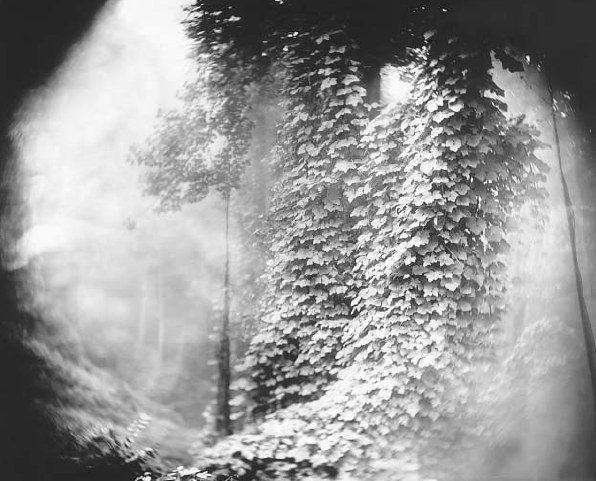
7. Sally Mann, Untitled (Georgia Landscape), 1996, silver print
Such cycles are linked to what Julia Kristeva has famously named “women's time.” “Women's time” is apart from “father's time,” apart from “history,” in that it evokes “the space of generating and forming the human species” and is a space of repetition and eternity.[15] Father's time, a sign of alteration, destruction, finality, has its own iconographic figure: Father Time. Father Time, as Erwin Panofsky has so beautifully demonstrated in Studies in Iconology: Humanistic Themes in the Art of the Renaissance, has been characteristically represented since the Renaissance with a scythe or hourglass, evoking time, not as eternity and creativity (as it was evoked in classical art), but as a cooler, calculated,
So while alteration and finality are central to Father Time, repetition is central to “women's time”—in the “cycles, gestation, the eternal recurrence of a biological rhythm.”[18] One need only think of the nursing mother, whose time is (un)structured by feedings every three hours—day and night. Likewise we imagine the earth in its seasons as a female body with its cycles. Eternity/maternity is the monumental time achieved through reproduction, in which the mother's gestating body cheats death. The belief that the body of the Virgin Mother does not die but moves from one spatiality to another, by the Assumption, mirrors this view of the maternal body as eternal. Eternity is the monumentality of the earth, always already there: Mother Earth.
The medium of Father Time is photography. Christian Metz knew this when he wrote that photography “remains closer to the pure index, stubbornly pointing to the print of what was, but no longer is.”[19] Roland Barthes knew it too when he wrote of the old wooden box cameras of the nineteenth century as “clocks for seeing.”[20] Yet because photography, like the maternal body, gestates copies of itself, it is as feminized through its reproduction as it is masculinized through its scientific clockwork exactness. The famed Winter Garden Photograph that Barthes describes in his book Camera Lucida—a photograph of his mother at age five that moved him, wounded him, stabbed him in the heart—demonstrates this laserlike exactness by taking a tiny bit of her light (from a past moment) and delivering a magically, uncannily perfect essence of her to her grown-up son “with its own rays and not with a superadded light.”[21] Poignantly, the Winter Garden Photograph is never reproduced in Camera Lucida, yet it reproduces itself: in Barthes's collecting of photographs; in his memories; in our own collecting of pictures; in our own memories as we conjure up the
Mann, as that other mother-photographer who is linked to Hawarden (by my book and by history's strange, magical umbilical cord, which puts young bodies into ancestral wombs of the past), mimics this maternal eternal time of the photograph (its very condition) with an emphasis on earth. While it is easy to make such a claim about her photographs of Virginian and Georgian landscapes, shown recently in the exhibition entitled Mother Land, one might say that her pictures have always held the repetition and eternity of “women's time.”
Perhaps Mann most urgently beckons play with “women's time” in her photographs of her daughter Virginia, for the name Virginia evokes Mann's mother land (her home state of Virginia), her childhood caregiver who was like a mother to her (a grand old woman named Virginia Carter), and her daughter. As Mann writes in the introductory pages of Immediate Family, the famed “family album” made public:
I have lived all my life in southwestern Virginia, the foothills of the Blue Ridge Mountains. And all my life many things have been the same. When we stop by to see Virginia Carter, for whom our youngest daughter is named, we rock on her cool blue porch. The men who walk by tip their hats, the women flap their hands languidly in our direction. Or at the cabin: the rain comes to break the heat, fog obscuring the arborvitae on the cliffs across the river. Some time ago I found a glass-plate negative picturing the cliffs in the 1800s. I printed it and held it up against the present reality, and the trees and caves and stains on the rock are identical. Even the deadwood, held in place by tenacious vines, has not slipped down.
Ninety-three years separate the two Virginias, my daughter and the big woman who raised me. The dark powerful arms are shrunken now, even as the tight skin of my daughter's [arms] pucker[s] with abundance. But, still, it seems that time effects slow changes here.[23]
Virginia is everywhere in Immediate Family. In The Two Virginias #1 (1988), Mann's daughter Virginia sits next to her ancient namesake, Virginia Carter; she is wearing a too-small cotton dress with appliquéd flower, lacy trim (passed down? new?); it is the dress that girls since the 1950s have worn, still wear. In The Two Virginias #2 (1989), ancient Virginia wears a wrinkle-free gingham dress, a sweater with its own flowers. Her aged and aging arm prompts my memory of the aging skin of my own grandmother and that of the loving grandmother in Swann's Way “which with age had acquired the purple hue of tilled fields in autumn.”[24] Her arms, which certainly as a child must have “puckered with abundance,” are very different now, no longer like the dimpled skin of little Virginia, whose right middle finger touches her namesake's old wicker chair but not her, and whose chubby left hand touches the persistently peeling fragile porch paint (old skin over brittle bone-dry wood). These old arms are like the great aunt's infusion of lime blossoms that Proust describes in Swann's Way: “having lost or altered their original appearance,” they now resemble “the most disparate things, the transparent wing of a fly, the blank side of a label, the petal of a rose…piled together, pounded or interwoven like the materials for a nest.”[25] Two years later, in The Two Virginias #4 (1991), the two Virginias sleep together in one nest, as if dead: the young Virginia in the heavy sleep of a child, the elderly Virginia in the light sleep of the old. Ancient Virginia's white hair is once again the hair of her baby days, soft loose curls, “like souls, remembering, waiting, hoping.”[26]
And even when neither little nor ancient Virginia is there, Virginia as leaves, earth, mountains, mud, stick, squash, morels, dead squirrels, field, yard eggs, dead deer, crabs, and river is there. (Virginia as mother land gives birth to Mann's son Emmett in The Ditch, 1987.)
Harder to look at than the family picture of Immediate Family, or the erotic pictures of Hawarden's daughters in fancy dress, or even the images by both photographers that feature a child dwarfed by encroaching land and a Brobdingnagian tree are Mann's and Hawarden's landscapes with no children at all.[27] I place Hawarden's Irish landscape of the River Multeen (Figure 8), whose winding way is mimetically suggested by the fence, the shadows of the fence, the path, the branches of the trees, and the (unseen) roots of the trees, which drink from the river's waters, next to Mann's Virginian river and trees (Figure 9).
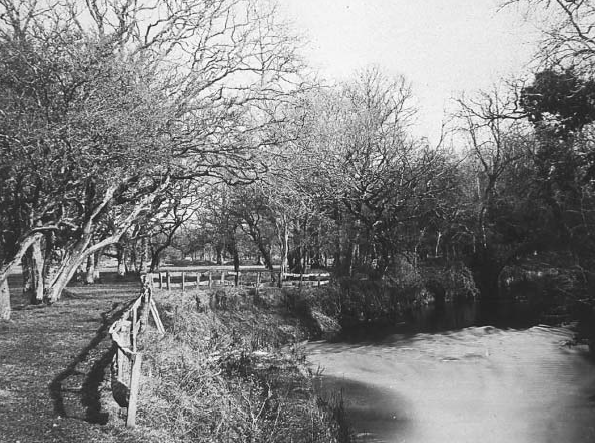
8. Clementina Hawarden, Untitled, 1857–64, photograph
Their waters inform each other. I seize on the universality of landscapes, here and elsewhere, now and then. I think about the taste of water, what gloomy waters hold, what floats on water, how I want to live in Dundrum, in Virginia, in the fantasies of pure quiet, wetness, and damp earth that they induce in me. I am learning from Sally Mann to see what has perhaps been too close to see.
Printed with a view camera, with old and flawed lenses, using the wet collodion process of the masters of the nineteenth century, soaking prints in tea—Mann's landscapes of Mother Land are unabashedly nostalgic. The word nostalgia is derived from the Greek nosos (“return to native land”) and algos (“suffering” or “grief”). “Nostalgia” is mother land missed. But the title of my essay also has a double meaning. Mann's Mother Land (and, in turn, Hawarden's) is not just a longing for the past; it is also a lesson forward: it teaches us not to overlook the landscape, which I had, personally, missed before.
Looking at Hawarden's landscapes through the lens of Mann's words and pictures, I begin to feel compelled. “It's not that they are easy to take or look at.”[28] They are not. Their boredom is their achievement
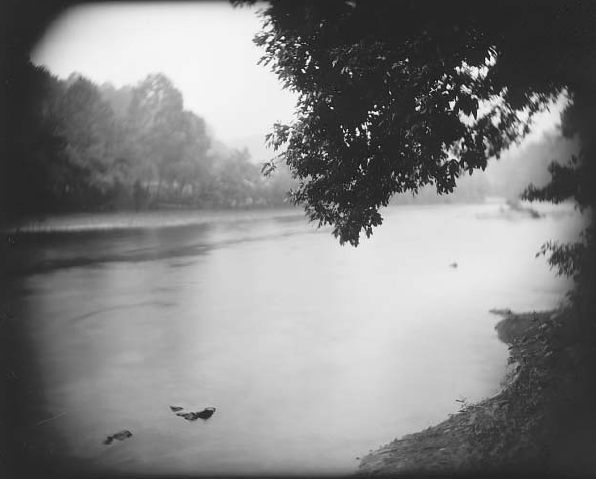
9. Sally Mann, Untitled (Virginia Landscape), 1995, silver print
NOTES
1. Lewis Carroll's secrets have captivated scholars for years, prompting such questions as: Why did Carroll suddenly quit photography in 1880? Did he really ask Alice Liddell, the real little girl of Alice in Wonderland fame, to marry him? Was Carroll's relationship with little girls more than play and picture taking? What kind of “more”? What was at the heart of the scandal between Alice's mother and Carroll?
2. Lewis Carroll [C.L. Dodgson], “Private Journal,” diary entry for July 22, 1864, British Museum, Add. 54343.
3. J.M. Barrie, Peter Pan (New York: Bantam Books, 1985), 1–2. The novel was first published under the title of Peter and Wendy in 1911. The play Peter Pan was written in 1904. For a critical history of the differences between the play and the novel see James Kincaid, Child-Loving: The Erotic Child and Victorian Culture (New York: Routledge, 1992), and Jacqueline Rose, The
4. D.W. Winnicott, Talking to Parents, ed. Clare Winnicott et al. (Reading, Mass.: Addison-Wesley, 1993), 72.
5. Marina Warner, “The Shadow of Young Girls in Flower,” introduction to Lady Hawarden: Studies from Life, 1857–1864, by Virginia Dodier (New York: Aperture, 1999), 6.
6. Mary Kelly, in an interview with Hal Foster entitled “That Obscure Subject of Desire,” in Interim (New York: New Museum of Contemporary Art, 1990), 55; reprinted in Mary Kelly, Imaging Desire (Cambridge, Mass.: MIT Press, 1996), 170.
7. Katherine Dieckmann, “Landscape and the Suspension of Time,” Village Voice, October 21, 1997, 50.
8. Ibid.
9. Sally Mann, “Correspondence with Melissa Harris,” Aperture 138 (Winter 1995): 2.
10. Adam Phillips, “On Being Bored,” in On Kissing, Tickling and Being Bored: Psychoanalytic Essays on the Unexamined Life (Cambridge, Mass.: Harvard University Press, 1993), 69.
11. Ibid.
12. Roland Barthes, Pleasure of the Text, trans. Richard Miller (New York: Hill and Wang, 1975), originally published as Le plaisir du texte (Paris: Éditions du Seuil, 1973).
13. Walter Benjamin, “The Storyteller,” in Illuminations: Essays and Reflections, trans. Harry Zohn (New York: Schocken, 1968), 91.
14. Jane Blocker, Where Is Ana Mendieta? Identity, Performativity, and Exile (Durham, N.C.: Duke University Press, 1999), 65.
15. Julia Kristeva, “Women's Time,” in The Kristeva Reader, ed. Toril Moi (New York: Columbia University Press, 1986), 190. First published as “Le temps de femmes” in 33/44: Cahiers de recherche de sciences des textes et documents 5 (Winter 1979): 5–19.
16. Erwin Panofsky, “Father Time,” in Studies in Iconology: Humanistic Themes in the Art of the Renaissance (New York: Harper and Row, 1962), 69–94.
17. Ibid., 93.
18. Kristeva, “Women's Time,” 191.
19. Christian Metz, “Photography and Fetish,” October 34 (Fall 1985): 83
20. Roland Barthes, Camera Lucida: Reflections on Photography, trans. Richard Howard (New York: Farrar, Straus and Giroux, 1981), 15. Originally published as La chambre claire (Paris: Éditions du Seuil, 1980).
21. Barthes, Camera Lucida, 81.
22. Barthes uses maternal metaphors in relation to photography throughout Camera Lucida. He specifically uses the metaphor of the “umbilicus” twice: see 81 and 110.
23. Sally Mann, Immediate Family (New York: Aperture, 1992), unpaginated.
24. Marcel Proust, Swann's Way, Remembrance of Things Past, trans. C.K. Scott Moncrief and Terrence Kilmartin (New York: Vintage, 1989), 13. More recently, as anyone familiar with Proust will know, the title has been translated as In Search of Lost Time. For an understanding of the appropriateness of this translation see, among others, Julia Kristeva's Time and Sense: Proust and the Experience of Literature, trans. Ross Guberman (New York: Columbia University Press, 1966), first published as Le temps sensible: Proust et l'expérience littéraire (Paris: Éditions Gallimard, 1994), and Mieke Bal, The Mottled Screen: Reading Proust Visually, trans. Anna-Louis Milne (Stanford, Calif.: Stanford University Press, 1997), from the French manuscript “Images proustiennes, ou comment lire visuellement.”
25. Proust, Swann's Way, 55.
26. Ibid., 50.
27. Brobdingnag is the place of Gulliver's second voyage, where everything is so gigantic as to make his normal size appear like that of someone from Lilliput.
28. Mann, “Correspondence with Melissa Harris,” 24.